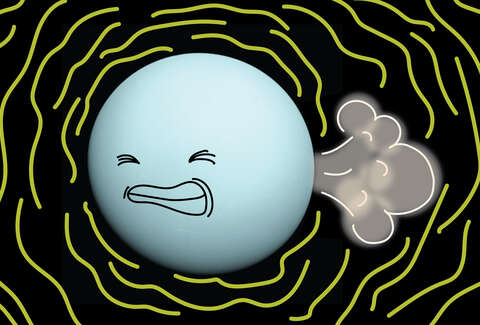
I could have posted this story from the source, Space.com, but LiveScience had the more interesting title.
Posted on 12/09/2018 11:38:01 AM PST by ETL
As a Jupiter-size world swings around its small but active star, bombarded by radiation, the planet leaves behind a tail of escaping helium as wide as itself — and researchers have spotted this tail from the ground, 163 light-years away.
Since scientists first found planets around other stars, many of their most striking discoveries have come from off-Earth instruments like NASA’s Kepler and Hubble space telescopes. Kepler has identified more than 2,000 verified planets passing by their stars, while Hubble observations have helped scientists characterize exoplanet atmospheres. But two new papers published today (Dec. 6) in the journal Science pinpoint the movement of helium in alien atmospheres from the comfort of our home planet. ..."
"This is the first time we can actually observe a helium tail," Lisa Nortmann, lead author on one of the new papers and a researcher at Instituto de Astrofísica de Canarias (IAC) in Spain, told Space.com. In their new paper, Nortmann's group looked for helium in the outer atmospheres of multiple planets. And one, called WASP-69b, showed a particularly dramatic effect.
"Before, it was assumed that if helium is in the [outermost atmospheric layer of a] planet, it might escape and form a tail. That was based on models, but this is the first time we can actually observe it while it's still in front of the star, when the planet is not in front of the star anymore," she said. Though WASP-69b is about the size of Jupiter, she said, it has the mass of Saturn, meaning it's lighter and fluffier than any of our solar system's planets.
(Excerpt) Read more at livescience.com ...

I could have posted this story from the source, Space.com, but LiveScience had the more interesting title.
Personally, I’d rather experience the texture, sounds and smells of Uranus.
We all have some special talent...maybe?
;)
GyG@PlanetWTF?
SemperTRUMP.45 NoMatterWot!
*****************************
MRIs are depleting helium. We need it.
That’s who I blame around our house for escaping gas but no one believes me.
Not mine you don’t!
Eeww,,,
That Is Weird.
Let me show you this funny trick I do with my colostomy bag.
I have trouble processing the fact that all of these planets and stars have to be perfectly aligned with earth for Kepler to spot them.
Addendum:
Best to remain silent especially in elevators, etc. where exits are not always readily available!
;)
*****
Let Me show You,,,
Does it utilize A Match?
No matches please!Look for a small space and burp it.
Methods of detecting exoplanets
From Wikipedia, the free encyclopedia
direct imaging
microlensing
transit
timing
radial velocity
Any planet is an extremely faint light source compared to its parent star. For example, a star like the Sun is about a billion times as bright as the reflected light from any of the planets orbiting it.
In addition to the intrinsic difficulty of detecting such a faint light source, the light from the parent star causes a glare that washes it out. For those reasons, very few of the extrasolar planets reported as of April 2014 have been observed directly, with even fewer being resolved from their host star.
Instead, astronomers have generally had to resort to indirect methods to detect extrasolar planets.
As of 2016, several different indirect methods have yielded success.
Contents
1 Established detection methods
1.1 Radial velocity
1.2 Transit photometry
1.2.1 Technique, advantages, and disadvantages
1.2.2 History
1.3 Reflection/Emission Modulations
1.4 Relativistic beaming
1.5 Ellipsoidal variations
1.6 Pulsar timing
1.7 Variable star timing
1.8 Transit timing
1.9 Transit duration variation
1.10 Eclipsing binary minima timing
1.11 Gravitational microlensing
1.12 Direct imaging
1.12.1 Early discoveries
1.12.2 Imaging instruments
1.13 Polarimetry
1.14 Astrometry
2 Other possible methods
2.1 Transit imaging
2.2 Magnetospheric radio emissions
2.3 Auroral radio emissions
2.4 Modified interferometry
https://en.wikipedia.org/wiki/Methods_of_detecting_exoplanets
Someone had fun writing that title.
*ping*
Helium is an alpha particle that has acquired two electrons, basically.
That leads me to wonder if there is a significant amount of alpha emitting radionuclides* in/on the planet or if some external (cosmic) radiation if interacting with the planet’s atmosphere.
*Alpha emitters tend to be at the high z area of the periodic table and could be indicators of elements in the thorium-uranium range.
Thanks ETL. It's the "Hello Kitty" planet! That's not a tail, it's a string with a plastic weight on the end.
 |
||
| · join · view topics · view or post blog · bookmark · post new topic · subscribe · | ||
| Google news searches: exoplanet · exosolar · extrasolar · | ||
I wonder if the farts sound funny, like a human voice after inhaling the gas.
Disclaimer: Opinions posted on Free Republic are those of the individual posters and do not necessarily represent the opinion of Free Republic or its management. All materials posted herein are protected by copyright law and the exemption for fair use of copyrighted works.